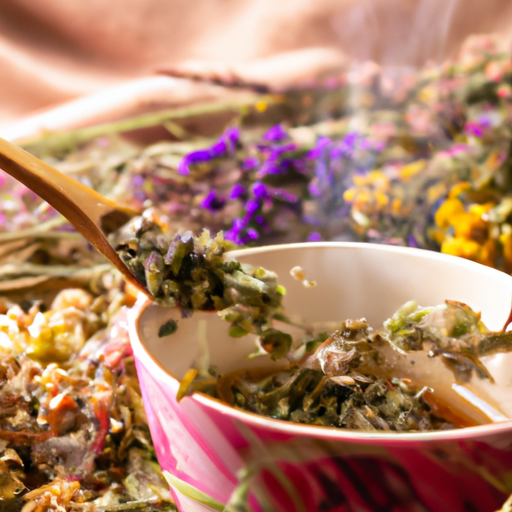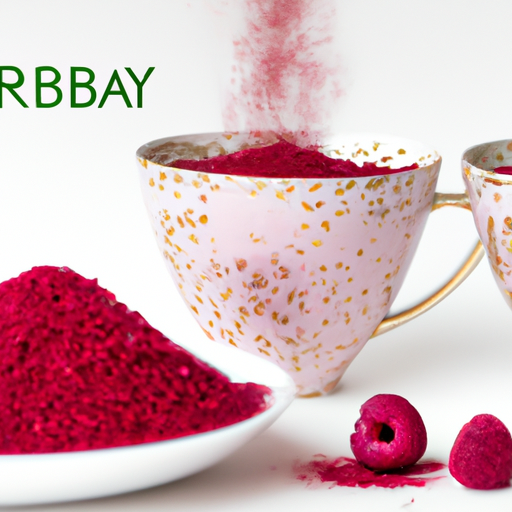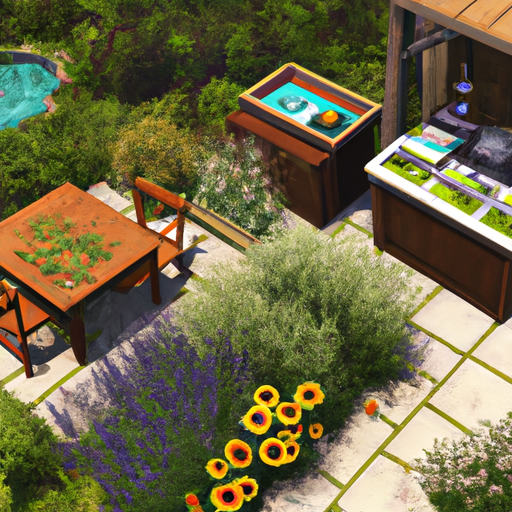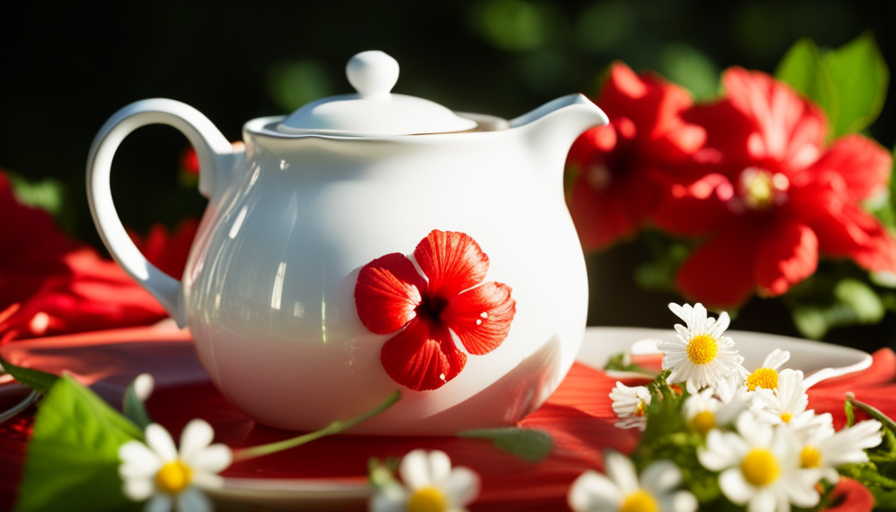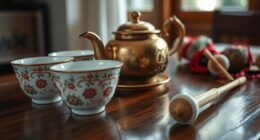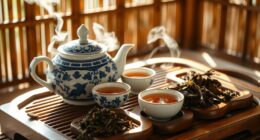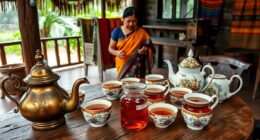You may be wondering, ‘I’m no tea connoisseur, so how can I make a great cup of herbal tea?’ Rest assured, brewing the perfect cup of herbal tea is simpler than you may think. Just follow a few easy steps, and you’ll soon be enjoying a delicious and calming drink.
In this article, I will guide you through the process of making a good cup of herbal tea, sharing my knowledge and expertise along the way.
Now, I know what you’re thinking. ‘Herbal tea? Isn’t that just a bunch of dried leaves in hot water?’ Well, my friend, I’m here to tell you that herbal tea is so much more than that. It’s a blend of carefully selected herbs, each with their own unique flavors and benefits.
By choosing the right blend, gathering the necessary ingredients and tools, boiling the water to the perfect temperature, steeping the tea for the right amount of time, and adding optional sweeteners or enhancements, you’ll be able to create a cup of herbal tea that is truly exceptional.
So, let’s get started and unlock the secrets to making the perfect cup of herbal tea!
Key Takeaways
- Choose the right herbal tea blend based on flavor preferences and health benefits desired.
- Use the appropriate water temperature for different herbs to avoid bitterness.
- Steep the tea for the recommended amount of time to achieve the desired strength.
- Experiment with sweeteners, enhancements, and straining techniques to customize the tea to personal preference.
Choose the Right Herbal Tea Blend
To make a good cup of herbal tea, you should choose the right herbal tea blend that suits your taste and preferences. When it comes to choosing the right herbal tea blend, it’s important to consider your flavor preferences and the health benefits you’re looking for.
There are countless options available, each with its own unique combination of flavors and potential health benefits. For example, if you enjoy floral and calming flavors, chamomile tea might be the perfect choice for you. On the other hand, if you’re looking for a refreshing and invigorating option, peppermint tea could be the way to go.
Once you’ve narrowed down your options, it’s time to gather your ingredients and tools for the next step in brewing the perfect cup of herbal tea.
Gather Your Ingredients and Tools
To make a good cup of herbal tea, it’s important to gather your ingredients and tools. First and foremost, it’s essential to use fresh, high-quality herbs. This ensures that you get the maximum flavor and benefits from your tea.
Additionally, having a tea infuser or strainer ready is crucial for brewing the tea and preventing any unwanted bits from ending up in your cup.
Use Fresh, High-Quality Herbs
Fresh, high-quality herbs are the Beyoncé of the herbal tea world, elevating your tea game to a whole new level. When it comes to choosing fresh herbs for your tea, it’s important to select ones that are vibrant in color and have a strong aroma. Look for herbs that are free from blemishes or signs of wilting.
Additionally, opt for organic herbs whenever possible to ensure they’re free from pesticides or other harmful chemicals.
To guarantee high-quality herbs, consider growing your own. This way, you have complete control over the growing process and can ensure that your herbs are as fresh as possible. Alternatively, you can purchase herbs from reputable sources that specialize in organic and high-quality products.
Having fresh, high-quality herbs is essential for a delicious cup of herbal tea. Once you have your herbs ready, it’s time to move on to the next step: having a tea infuser or strainer ready to brew your tea.
Have a Tea Infuser or Strainer Ready
Make sure you have a trusty tea infuser or strainer on hand, ready to capture all the flavorful essence of your vibrant, aromatic herbs as you steep them in hot water. While a tea infuser is the most popular choice, there are other tea infuser alternatives available, such as tea balls or muslin bags. The key is to have a method that allows the herbs to infuse freely while keeping them contained.
Using loose leaf tea is important because it allows the water to flow through the leaves, extracting their natural flavors and nutrients more effectively than tea bags. This results in a richer, more robust cup of herbal tea.
To continue the brewing process, the next step is to boil the water to the right temperature…
Boil the Water to the Right Temperature
When making a good cup of herbal tea, it’s important to boil the water to the right temperature. Different herbs require different water temperatures in order to extract their flavors and benefits effectively.
For example, delicate herbs like chamomile and lavender shouldn’t be steeped in boiling water, as it can result in a bitter taste. By understanding and adjusting the water temperature according to the herb being used, you can ensure a delicious and enjoyable cup of herbal tea every time.
Different Herbs Require Different Water Temperatures
Although each herb has its own unique flavor, steeping times, and water temperatures that release its full potential, it’s important to remember that different herbs require different water temperatures for the perfect cup of herbal tea. To achieve the best results, here are three key factors to consider:
-
Chamomile: This delicate herb should be steeped in water that’s been heated to around 190°F (88°C). This temperature allows the delicate flavors of chamomile to infuse gently, resulting in a soothing and calming cup of tea.
-
Peppermint: For a refreshing and invigorating cup of peppermint tea, use water that’s reached a rolling boil at 212°F (100°C). The high temperature helps to extract the bold and minty flavors, creating a revitalizing beverage.
-
Green tea: To bring out the subtle and complex flavors of green tea, use water that’s been heated to approximately 175°F (79°C). This lower temperature preserves the delicate nature of green tea, resulting in a smooth and refreshing brew.
Remember, when brewing herbal tea, it’s crucial to avoid boiling water for delicate herbs. Transitioning into the next section, let’s explore the impact of water temperature on the flavors of these herbs.
Avoid Boiling Water for Delicate Herbs
Now that we know different herbs require different water temperatures, it’s important to understand that delicate herbs should never be steeped in boiling water. Delicate herbs, such as chamomile or lavender, can lose their delicate flavors and aromas if exposed to high temperatures. Instead, it’s recommended to use water that’s just below boiling point, around 170-190°F (76-88°C).
This temperature range allows the delicate flavors of the herbs to slowly infuse into the water without being overwhelmed by the heat. Additionally, using filtered water is crucial to ensure a clean and pure taste. Avoid steeping the tea for too long, as this can result in a bitter taste.
Now that we have the right water temperature, let’s move on to the next step and discuss the importance of steeping the tea for the right amount of time.
Steep the Tea for the Right Amount of Time
When it comes to steeping herbal tea, it’s crucial to follow the recommended steeping time. This ensures that the flavors and health benefits are extracted properly without becoming bitter or overpowering.
However, if you prefer a stronger cup of tea, you can adjust the steeping time to your liking. By allowing the tea to steep for a longer period, you can enhance the taste and intensity of the brew.
Follow the Recommended Steeping Time
To create a truly exquisite cup of herbal tea, you’ll want to steep it for the recommended amount of time, allowing the flavors to infuse and develop into a delightful sensory experience.
Choosing the right tea blend is essential to achieve the desired taste, as each blend has its unique characteristics. Experimenting with different steeping times can also enhance the flavor profile of your herbal tea.
Steeping times typically range from 5 to 7 minutes, but it’s crucial to follow the specific instructions provided by the tea manufacturer. Some herbs may release their flavors quickly, while others require a longer steeping time to fully develop.
By following the recommended steeping time, you ensure that the tea extracts the maximum flavors and benefits. So, let’s dive into how to adjust steeping time based on desired strength for an even more personalized tea experience.
Adjust Steeping Time Based on Desired Strength
For a tea experience that’ll blow your taste buds away, adjust the steeping time based on your desired strength and watch the flavors explode in your cup! Adjusting steeping time for different herbal tea blends is essential to extract the maximum flavor from each blend.
Some herbal teas, like chamomile or peppermint, require longer steeping times to fully release their essential oils and flavors. Experimenting with longer steeping times can result in a stronger flavor profile, allowing you to customize your tea to your preference. However, be cautious not to oversteep as this can lead to a bitter taste.
Keep in mind that each herbal tea blend is unique, so play around with the steeping time until you find the perfect balance.
Now, let’s move on to the next section and explore the optional step of adding sweeteners or enhancements to your herbal tea.
Add Sweeteners or Enhancements (Optional)
When it comes to adding sweeteners or enhancements to herbal tea, there are a few options to consider. Natural sweeteners like honey or stevia can add a touch of sweetness without overpowering the herbal flavors.
Additionally, adding citrus zest or spices can provide a burst of flavor and aroma, elevating the tea to a whole new level. Experimenting with different combinations can help create a personalized and delightful cup of herbal tea.
Explore Natural Sweeteners like Honey or Stevia
While exploring natural sweeteners like honey or stevia, it’s essential to consider their unique flavor profiles and how they can complement the natural flavors of herbal tea. Natural sweeteners provide an alternative to refined sugar, adding a touch of sweetness without overpowering the delicate herbal notes. Honey, for example, offers a rich and floral taste that pairs well with floral herbal teas like chamomile or lavender. On the other hand, stevia is a natural, zero-calorie sweetener that works perfectly for those looking to reduce their sugar intake. To help you decide which sweetener to use, here’s a comparison table:
| Sweetener | Flavor Profile | Best Tea Pairing |
|---|---|---|
| Honey | Rich, Floral | Chamomile, Lavender |
| Stevia | Mild, Herbal | Green, Mint |
By incorporating these natural sweeteners, you can enhance the taste of your herbal tea while keeping it wholesome and nutritious. Now, let’s consider adding citrus zest or spices for flavor.
Consider Adding Citrus Zest or Spices for Flavor
Adding citrus zest or spices to your herbal tea will transport your taste buds to a flavor paradise they never knew existed. Not only do these additions enhance the taste, but they also offer a range of benefits.
Firstly, citrus zest adds a refreshing and tangy twist to your tea, giving it a burst of citrusy goodness. It’s also a great source of vitamin C and antioxidants, which can boost your immune system and promote healthy skin.
Secondly, experimenting with different spices can elevate your tea to new heights. Cinnamon adds warmth and depth, ginger adds a spicy kick, and cardamom adds a unique and exotic flavor. Don’t be afraid to mix and match to find your perfect blend.
So, once you’ve infused your tea with these delightful flavors, it’s time to strain and serve, creating a soothing and aromatic cup of herbal tea.
Strain and Serve
To strain and serve the herbal tea, gently pour the infused liquid into a teapot or directly into cups. Straining techniques are essential to remove any loose herbs or particles, ensuring a smooth and enjoyable cup of tea.
One method is to use a fine-mesh strainer or a tea infuser to catch any debris. Another option is to use a cheesecloth or muslin cloth to strain the liquid, which allows for a more thorough removal of any unwanted ingredients.
Once strained, you can serve the herbal tea as is, or you can enhance the experience by adding a slice of lemon or a sprig of fresh mint. These serving suggestions add a delightful touch of freshness and aroma to the tea, elevating its flavor profile.
With the tea strained and beautifully presented, it’s time to move on to the next step: enjoying your perfect cup of herbal tea.
Enjoy Your Perfect Cup of Herbal Tea
Savor the delightful flavors and soothing qualities of your perfectly brewed herbal tea. To enjoy your perfect cup of herbal tea, start by choosing the perfect tea blend. Consider your taste preferences and the benefits you seek from drinking herbal tea. Whether you want to relax, boost your immune system, or improve digestion, there’s a blend for you. Look for ingredients like chamomile, peppermint, or ginger, depending on your desired effect.
Once you’ve chosen your blend, follow the brewing instructions carefully, ensuring the water temperature and steeping time are correct. This’ll help release the optimal flavors and health benefits. Finally, take a moment to appreciate the aroma and taste of your tea as you sip it slowly. Allow the warmth and comfort to wash over you, knowing that you’ve made the perfect cup of herbal tea to nourish both body and soul.
Frequently Asked Questions
Can I use any type of herbal tea blend for making a good cup of herbal tea?
Sure, any type of herbal tea blend can be used to make a good cup of herbal tea. Experiment with different blends to find your favorite. Drinking herbal tea offers numerous benefits, including relaxation, hydration, and potential health benefits.
What are some common tools and ingredients required for making herbal tea?
To make a great cup of herbal tea, you’ll need a few essentials: a teapot or infuser, fresh water, and your choice of herbal tea blends. Trying different types of herbal teas can offer various benefits, like improved digestion and relaxation.
How long should I boil the water before steeping the herbal tea?
Boiling time for herbal tea varies but generally, 3-5 minutes is sufficient. Steeping duration depends on personal preference and the type of tea. Experiment with different times to find your perfect cup.
Are there any specific guidelines for steeping different types of herbal tea blends?
Steeping techniques for different types of herbal tea blends vary. For delicate floral blends, steep for 3-5 minutes in water just below boiling point. Robust blends like peppermint should steep for 5-7 minutes. Enjoy herbal tea blends anytime throughout the day.
What are some popular sweeteners or enhancements that can be added to herbal tea?
"Enhance your herbal tea experience with popular sweeteners like honey or agave syrup. You can also add a twist by incorporating enhancements like lemon or ginger for added flavor and health benefits."
Conclusion
In conclusion, making a good cup of herbal tea is a delightful process that requires a bit of knowledge and attention to detail. By choosing the right blend, gathering the necessary ingredients and tools, boiling the water to the right temperature, steeping the tea for the right amount of time, and adding optional sweeteners or enhancements, you can create a truly perfect cup of herbal tea.
So, next time you’re in need of a soothing and flavorful beverage, follow these steps and savor the aromatic experience that awaits you. Remember, the art of tea-making is a journey that invites us to slow down and appreciate life’s simple pleasures.

